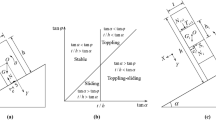Abstract
A discontinuous deformation and displacement (DDD) analysis method is proposed for modelling the rock failure process. This method combines the rock failure process analysis (RFPA) method (based on finite element method) and discontinuous deformation analysis (DDA) method. RFPA is used to simulate crack initiation, propagation and coalescence processes of rock during the small deformation state. The DDA method is used to simulate the movement of blocks created by the multiple cracks modelled by the RFPA. The newly developed DDD method is particularly suitable for modelling both crack propagation and block movement during the rock failure process because of the natural and convenient coupling of continuous and discontinuous deformation analyses. The proposed method has been used to simulate crack initiation, propagation and coalescence within a slope as well as the block movement during the landslide process. Numerical modelling results indicate that the proposed DDD method can automatically simulate crack propagation and block movement during the rock failure process without degrading accuracy.
Similar content being viewed by others
References
Hudson J A, Harrison J P. Engineering Rock Mechanics-An Introduction to the Principles. Oxford: Pergamon, 1997
Cundall P A. A computer model for simulating progressive large scale movements in blocky rock systems. In: Proceedings of the Symposium of the International Society for Rock Mechanics (ISRM), Nancy, France, 1971. 129–136
Shi G H. Discontinuous deformation analysis: A new numerical model for the statics and dynamics of block systems. Dissertation of Doctor Degree. Berkeley: University of California, 1988
Tang C A. Numerical simulation of progressive rock failure and associated seismicity. Int J Rock Mech Min Sci, 1997; 34: 249–261
Tang S B, Tang C A. Crack propagation and coalescence in quasi- brittle materials at high temperatures. Eng Fract Mech, 2015; 134: 404–432
Tang S B, Tang C A. Numerical studies on tunnel floor heave in swelling ground under humid conditions. Int J Rock Mech Min Sci, 2012; 55: 139–150
Jiang Q H, Sun J S, Wei W, et al. A numerical model coupling three-dimensional discontinuous deformation analysis (3D DDA) with finite element method. Adv Sci Lett, 2013; 19: 2736–2740
Cheng Y M, Zhang Y H. Coupling of FEM and DDA methods. Int J Geomechanics, 2002; 2: 503–517
Bai W, Lin B. Numerical simulations of deformation and movement of blocks within North China in response to 1976 Tangshan earthquake. Sci China Ser D, 2003; 46: 141–152
Manthei G. Characterization of acoustic emission sources in a rock salt specimen under triaxial compression. B Seismol Soc Am, 2005; 95: 1674–1700
Basu B, Tiwari D, Kundu D, Prasad R. Is Weibull distribution the most appropriate statistical strength distribution for brittle materials? Ceram Int, 2009; 35: 237–246
Weibull W. The Phenomenon of Rupture in Solids. Stockholm: Generalstabens Litografiska Anstalts Forlag, 1939
Mazars J, Pijaudier C G. Continuum damage theory-application to concrete. J Eng Mech-ASCE, 1989; 115: 345–365
Cerrolaza M, Garcia R. Boundary elements and damage mechanics to analyze excavations in rock mass. Eng Anal Bound Elem, 1997; 20: 1–16
Xue X H, Yang X G, Chen X. Application of a support vector machine for prediction of slope stability. Sci China Tech Sci, 2014; 57: 2379–2386
Zhang W, Chen J P, Zhang W, et al. Determination of critical slip surface of fractured rock slopes based on fracture orientation data. Sci China Tech Sci, 2013; 56: 1248–1256
Tang C A, Li L C, Li C W. RFPA strength reduction method for stability analysis of geotechnical engineering (in Chinese). Chin J Rock Mech Eng, 2006; 25: 1522–1530
Author information
Authors and Affiliations
Corresponding author
Rights and permissions
About this article
Cite this article
Tang, C., Tang, S., Gong, B. et al. Discontinuous deformation and displacement analysis: From continuous to discontinuous. Sci. China Technol. Sci. 58, 1567–1574 (2015). https://doi.org/10.1007/s11431-015-5899-8
Received:
Accepted:
Published:
Issue Date:
DOI: https://doi.org/10.1007/s11431-015-5899-8




